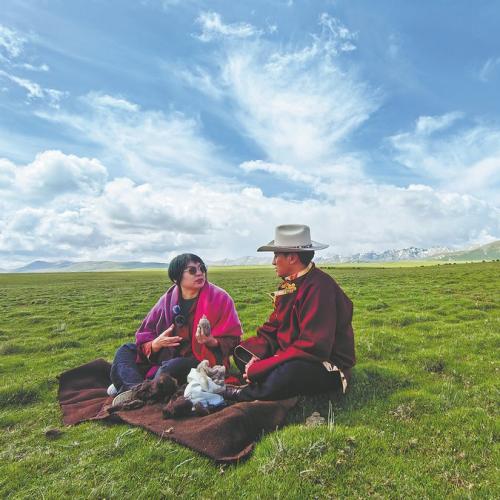



With a pasture turning into a natural runway, over 40 Tibetan models showcased 100-plus pieces of clothing primarily made of locally featured yak wool during a fashion show staged on June 28 in Madoi county, Golog Tibetan autonomous prefecture, Qinghai province.
Guo Xiuling, 53, founder of Shanghai-based luxury fashion brand Sandriver, is the fashion show's organizer. As a native of the Alashan Plateau, Inner Mongolia autonomous region, Guo has come a long way, staying committed to bringing the featured fabrics and unique craftsmanship from China's plateaus to the world.
The brand has been invited to Paris Fashion Week for 10 consecutive years and several times to the Maison & Objet, a renowned home decor expo in Paris.
"We are committed to pursuing excellence and high quality and strive to build the world's top Chinese brand, to speak out for China and to showcase 'quality Chinese product-making'," says Guo, who described herself as a "Shanghai craftswoman".

Guo's experiences also depict a story of pursuing excellence, aiming at the top and transcending boundaries. Actually majored in philosophy and economics in her senior education, Guo gave up her job as a teacher in 1991 and worked in a textile factory.
"I knew nothing when I entered the industry but I worked hard to stand out and succeed in the textile sector," Guo says.
After becoming a technical expert in her first factory, Guo was invited to work in Germany in 2000 where she became a world-leading technical master in the textile program with more than 200 technical patents. After returning to China for 10 years and leading a big team as a supplier for top international luxury brands, Guo founded Sandriver in 2012 in Shanghai's Jinshan district.
"The quality of Chinese manufacturing is already top-notch. However, there are few Chinese brands that showcase the spirit of Chinese craftsmanship and can compete with foreign luxury names on the world stage," Guo says.

That is the goal of her brand. Positioned as an international brand, it has been focusing on the restoration and innovation of traditional fabrics and unique craftsmanship rooted in Inner Mongolia and the Qinghai-Xizang Plateau.
"If we want to build a world-class Chinese brand, we must dig deep into traditional Chinese cultures, raw materials and crafts, especially those less-known from ethnic groups in which we have seen enormous potential to make our brands stand out on the global stage," Guo says.
The recent Madoi show demonstrated efforts, outcomes and ambition by Guo and her team.
Located in the heartland of the Qinghai-Xizang Plateau, Golog Tibetan autonomous prefecture has an average altitude of 4,000 meters above sea level. The yak plays a symbolic and critical role in the residents' daily lives and production.

Yak wool has long been an essential material for making yurts and clothing in Tibetan ethnic areas. During the down season, a yak produces an average of up to 300 grams of down. After cleaning and post-processing, the output of yak wool is significantly reduced. Thus, the yak wool is of top quality and has high economic and cultural value.
Apart from the precious raw material, the craftsmanship of processing yak wool is also worth noting.
"We have revolutionized and integrated textile techniques (when it comes to yak wool)," Guo explains. "The Inner Mongolia autonomous region is home to the best cashmere, while the Xizang autonomous region boasts the best crafts from cashmere processing. To make the scratchy yak wool skin-friendly, we integrated our traditional craftsmanship of Inner Mongolian handmade felting and the hand-woven Tibetan pulu (a kind of woolen fabric) in processing the yak wool."

The rebirth of the dying traditional craft was not easy. Before the Madoi show, Guo spent about 10 years restoring Inner Mongolian handmade felting and another two years conserving and optimizing hand-woven Tibetan pulu.
"As society and the economy develop, declining usage scenarios in residents' daily lives have led to the demise of traditional crafts. Some intangible cultural heritages are going extinct," Guo says.
Fortunately, her efforts have reaped returns.
With the restored craft of Inner Mongolian handmade felting, the brand became the first and only Chinese brand invited to be sold at Le Bon Marche, a top department store in Paris.
With traditional crafts coming back to life and shining in fashion and art pieces, residents in remote plateau areas are expected to pass on the precious cultural heritages while gaining a better quality of life.

"In the process of development and production of Sandriver's yak wool products, local herdsmen and women are empowered to find jobs and gain income in places close to their homes, boosting local economic development," says Wang Qiyang, deputy head of Madoi county.
Guo's journey continues. Next, she will travel to Southwest China's Yunnan province and Northwest China's Xinjiang Uygur autonomous region for more discovery and further integration.
"We are not Hermes or some other big luxury name. As a Chinese brand, we are committed to making our voice heard and showing the world Chinese materials and production. The spirit that Sandriver embodies is the spirit of Chinese people, which is the integration of profound Chinese cultures," Guo says.
If you have any problems with this article, please contact us at app@chinadaily.com.cn and we'll immediately get back to you.